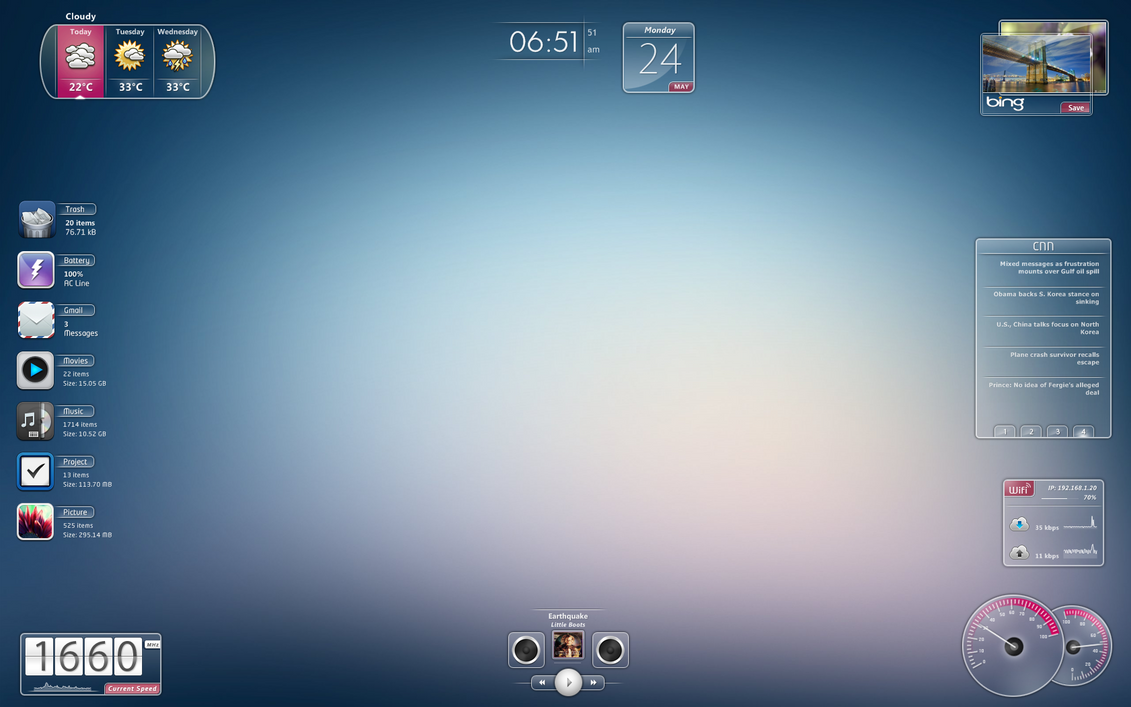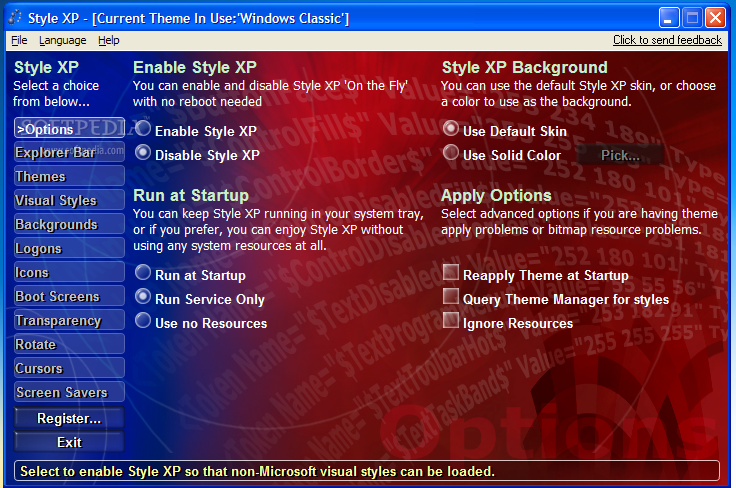Download How to edit skins
Editing skins is a very simple matter. While every skin is a file with the extension ".ini", they're really just regular text documents. You can open any skin file with Notepad (or your preferred text editor) and edit them directly. It is important that your editor be a plaintext editor. That means no programs like Microsoft Word, Works, OpenOffice.org or any other document editor. You'll want one that does just text without the formatting.
Once a skin is edited, Rainmeter will reflect the changes the next time it is refreshed. If the skin is already running, you will have to refresh it manually. Otherwise, just start the skin and your changes should be there.
How to create a new skin
To create a skin, you must first find your skins folder. If you installed Rainmeter normally, the skins folder will be found in one of these locations:
Windows XP: C:\Documents and Settings\
Your Name\My Documents\Rainmeter\Skins\
Windows Vista and 7: C:\Users\
Your Name\Documents\Rainmeter\Skins
Basically, just head over to "My Documents" and look for the "Rainmeter" folder. In there you'll find the "Skins" folder. Once you're in there, make a new folder. Call this folder whatever you like. Within this folder make a new text document and call it whatever you like. Make sure that the text document's file extension is ".ini" and not ".txt". There you have it. You now have a brand new, albeit empty, skin. If you right-click the Rainmeter icon in the taskbar and choose "Refresh All", your new skin will be available for use. Don't start it up yet though, it doesn't do anything!
How to install skins
If you have a skin that was downloaded from he internet, installing it is very similar to creating a new skin. First, if the skin came in an archive (such as ".zip" or ".rar") you will need to extract it. Once the files are extracted, make sure that they are all contained within a single folder. Often, skin makers will havev this folder already in the archive. Otherwise, you will have to make it yourself. Move this folder to your Skins directory (one of the paths show in the section above). If Rainmeter is already running, right-click the icon in the taskbar and choose "Refresh All". Your downloaded skin should now appear in the "Configs" list.
Loading a skin
To load a skin, first make sure that Rainmeter is already running. Right-click the icon in the taskbar to open the context menu and navigate to "Configs". Here, a list of all of the folders in your Skins directory should appear. From there just choose the folder holding the skin you want and load up the appropriate .ini file.
NOTE: You can only load one .ini file from a specific folder at once. If you want two skins to run simultaneously you will need to have each one in its own folder.
Using Rainmeter
While using Rainmeter, you will want to load and unload skins, change certain settings of skins like transparency, position and other behaviors, refresh and exit Rainmeter. Interacting with Rainmeter can be done two ways. The first is through the "Context Menu" for Rainmeter found in the Windows System Tray, and the second is with the RainBrowser GUI application. They both do similar things, and it is up to you which you use.
The Rainmeter system tray icon "Context Menu"

- About - Shows the version of Rainmeter and current values for all "measures"
- Help - Launches the Rainmeter Help system
- Configs - Shows all "skins" available for loading:

- Themes - Shows all available RainThemes "Theme" files
- Edit Settings - Edits Rainmeter.ini in your default text editor
- Refresh All - Refreshes all running skins
- Show Log File - Creates and / or displays the Rainmeter log file
- Running Skins - List of all skins currently loaded
Hover over a running skin to control many skin settings:

- Exit - Exit Rainmeter
RainBrowser
 Active
Active View - Shows a list of currently running skins
 Browse
Browse View - Shows a list of all your skins
 Tags
Tags View - Lists skins by "Tags" in "Metadata"

Control the Rainmeter program with
Global ActionsLoad, unload and edit skins with
Skin ActionsChange a running skin's behavior with
Skin SettingsRainmeter.ini
The file Rainmeter.ini is used by Rainmeter for global settings, as well as keeping track of the currently loaded skins and settings for them.
By defaut, Rainmeter.ini is created by Rainmeter in:
Windows XP: C:\Documents and Settings\YourName\Application Data\Rainmeter
Windows Vista / Win7: C:\Users\YourName\Appdata\Roaming\Rainmeter
Rainmeter.ini can be edited by right-clicking the system tray icon for Rainmeter and saying "Edit Settings" or by using RainBrowser and clicking "Edit Settings" under "Global Actions".
There is a full explanation of the information in Rainmeter.ini at
Manual - Settings, but there are a couple of things we should mention at a high level.
There are several [Sections] in Rainmeter.ini. Let's take a quick look at two of them.
[Rainmeter]ConfigEditor="C:\Program Files\Notepad++\Notepad++.exe"
This setting will tell Rainmeter (and RainBrowser) which text editor you wish to use to edit skins and settings. The default is the built-in Windows Notepad application.
Note: Do NOT use any editor which doesn't save plain text. Word for Windows or other "word processors" will cause problems.SkinPath=C:\Users\
YourName\Documents\Rainmeter\Skins\
This is normally set automatically by Rainmeter when you install the application. It will point to the place you use to store your "Skins".
[ConfigName]There will be a section like this for each config you have ever loaded in Rainmeter. It keeps track of whether the skin is "active" and important skin settings. When you unload a skin, it is not removed from Rainmeter.ini, but is just marked "inactive".
If you load and unload a lot of skins, maybe trying things out from download sites that you don't end up keeping, you might want to occasionally edit Rainmeter.ini and remove sections you will never need. A really large Rainmeter.ini with a lot of unneeded sections can slow down the initial load of Rainmeter a bit.



















